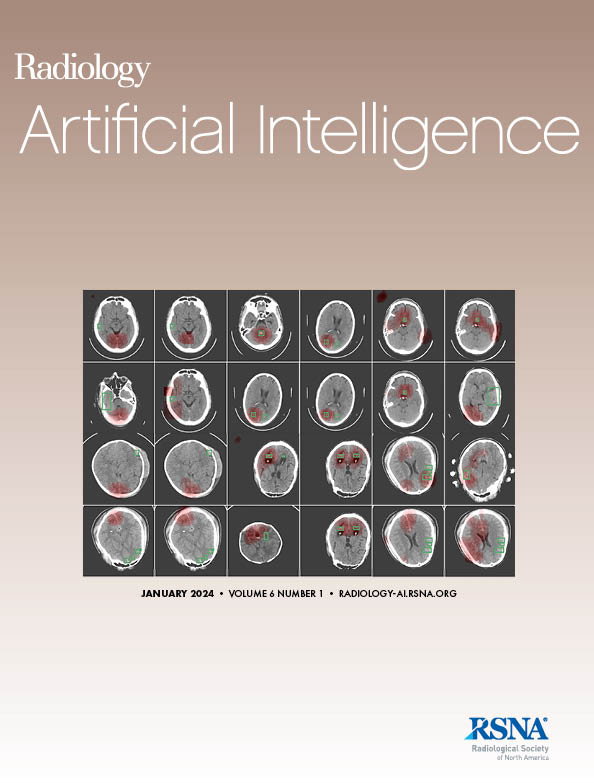下载PDF
{"title":"eRadiomics 超越炒作:面向肿瘤临床应用的严格评估。","authors":"Natally Horvat, Nikolaos Papanikolaou, Dow-Mu Koh","doi":"10.1148/ryai.230437","DOIUrl":null,"url":null,"abstract":"<p><p>Radiomics is a promising and fast-developing field within oncology that involves the mining of quantitative high-dimensional data from medical images. Radiomics has the potential to transform cancer management, whereby radiomics data can be used to aid early tumor characterization, prognosis, risk stratification, treatment planning, treatment response assessment, and surveillance. Nevertheless, certain challenges have delayed the clinical adoption and acceptability of radiomics in routine clinical practice. The objectives of this report are to (<i>a</i>) provide a perspective on the translational potential and potential impact of radiomics in oncology; (<i>b</i>) explore frequent challenges and mistakes in its derivation, encompassing study design, technical requirements, standardization, model reproducibility, transparency, data sharing, privacy concerns, quality control, as well as the complexity of multistep processes resulting in less radiologist-friendly interfaces; (<i>c</i>) discuss strategies to overcome these challenges and mistakes; and (<i>d</i>) propose measures to increase the clinical use and acceptability of radiomics, taking into account the different perspectives of patients, health care workers, and health care systems. <b>Keywords:</b> Radiomics, Oncology, Cancer Management, Artificial Intelligence © RSNA, 2024.</p>","PeriodicalId":29787,"journal":{"name":"Radiology-Artificial Intelligence","volume":null,"pages":null},"PeriodicalIF":8.1000,"publicationDate":"2024-07-01","publicationTypes":"Journal Article","fieldsOfStudy":null,"isOpenAccess":false,"openAccessPdf":"https://www.ncbi.nlm.nih.gov/pmc/articles/PMC11294952/pdf/","citationCount":"0","resultStr":"{\"title\":\"Radiomics Beyond the Hype: A Critical Evaluation Toward Oncologic Clinical Use.\",\"authors\":\"Natally Horvat, Nikolaos Papanikolaou, Dow-Mu Koh\",\"doi\":\"10.1148/ryai.230437\",\"DOIUrl\":null,\"url\":null,\"abstract\":\"<p><p>Radiomics is a promising and fast-developing field within oncology that involves the mining of quantitative high-dimensional data from medical images. Radiomics has the potential to transform cancer management, whereby radiomics data can be used to aid early tumor characterization, prognosis, risk stratification, treatment planning, treatment response assessment, and surveillance. Nevertheless, certain challenges have delayed the clinical adoption and acceptability of radiomics in routine clinical practice. The objectives of this report are to (<i>a</i>) provide a perspective on the translational potential and potential impact of radiomics in oncology; (<i>b</i>) explore frequent challenges and mistakes in its derivation, encompassing study design, technical requirements, standardization, model reproducibility, transparency, data sharing, privacy concerns, quality control, as well as the complexity of multistep processes resulting in less radiologist-friendly interfaces; (<i>c</i>) discuss strategies to overcome these challenges and mistakes; and (<i>d</i>) propose measures to increase the clinical use and acceptability of radiomics, taking into account the different perspectives of patients, health care workers, and health care systems. <b>Keywords:</b> Radiomics, Oncology, Cancer Management, Artificial Intelligence © RSNA, 2024.</p>\",\"PeriodicalId\":29787,\"journal\":{\"name\":\"Radiology-Artificial Intelligence\",\"volume\":null,\"pages\":null},\"PeriodicalIF\":8.1000,\"publicationDate\":\"2024-07-01\",\"publicationTypes\":\"Journal Article\",\"fieldsOfStudy\":null,\"isOpenAccess\":false,\"openAccessPdf\":\"https://www.ncbi.nlm.nih.gov/pmc/articles/PMC11294952/pdf/\",\"citationCount\":\"0\",\"resultStr\":null,\"platform\":\"Semanticscholar\",\"paperid\":null,\"PeriodicalName\":\"Radiology-Artificial Intelligence\",\"FirstCategoryId\":\"1085\",\"ListUrlMain\":\"https://doi.org/10.1148/ryai.230437\",\"RegionNum\":0,\"RegionCategory\":null,\"ArticlePicture\":[],\"TitleCN\":null,\"AbstractTextCN\":null,\"PMCID\":null,\"EPubDate\":\"\",\"PubModel\":\"\",\"JCR\":\"Q1\",\"JCRName\":\"COMPUTER SCIENCE, ARTIFICIAL INTELLIGENCE\",\"Score\":null,\"Total\":0}","platform":"Semanticscholar","paperid":null,"PeriodicalName":"Radiology-Artificial Intelligence","FirstCategoryId":"1085","ListUrlMain":"https://doi.org/10.1148/ryai.230437","RegionNum":0,"RegionCategory":null,"ArticlePicture":[],"TitleCN":null,"AbstractTextCN":null,"PMCID":null,"EPubDate":"","PubModel":"","JCR":"Q1","JCRName":"COMPUTER SCIENCE, ARTIFICIAL INTELLIGENCE","Score":null,"Total":0}
引用次数: 0
引用
批量引用

 求助内容:
求助内容: 应助结果提醒方式:
应助结果提醒方式:


